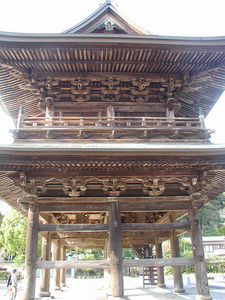Kenchô-ji is the top temple of the Kamakura Gosan (Kamakura Five [top Zen] Temples), and the head temple of the Kenchô-ji branch of Rinzai Zen.
It was founded in 1253, when Hôjô Tokiyori invited the Chinese (Song) monk Dôryû to found it. Dôryû would be the first to be named a Japanese Zen master by a Japanese Emperor.
Though originally quite large, with 49 tatchû (sub-compounds), after many fires and such in the Sengoku period, Kenchô-ji was rebuilt in the Edo period in its current form, as just a single temple complex. A Shintô shrine located in the hills directly above the temple serves as the chinju guardian shrine for the temple; chiefly associated with Hansôbô gongen, a deified tengu, the shrine contains includes numerous statues of tengu, scattered across a small section of the hill.
A dragon painting on the ceiling of the hattô (lecture hall) was created by Nihonga painter Koizumi Junsaku in 2000, in honor of the then-upcoming 750th anniversary of the temple's founding.
The temple's bell, cast in 1255, has been designated a National Treasure, while the main gate to the temple, built in 1754, is known as the Tanuki-mon ("badger gate") on account of a legend involving a tanuki who transformed himself into a monk and worked to raise money for the gate, in order to repay the monks' kindness to him.
References
- Plaques on-site.
- "Kenchô-ji." Kamakura-Burabura.com 鎌倉ぶらぶら.
